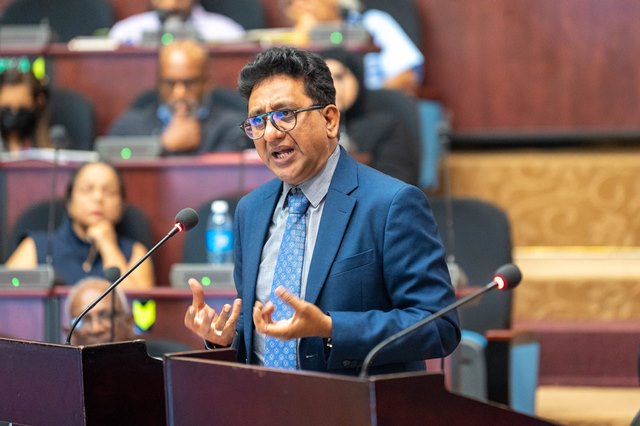

The Indian Government, which has been long eyeing Guyana’s burgeoning oil and gas industry especially the light sweet crude being produced here, is now pushing for a long-term partnership as the two countries ink a cooperation agreement that opens up a host of opportunities for collaboration.
As part of the historic visit of India’s Prime Minister, Narendra Modi, to Guyana, several bilateral agreements were signed on Wednesday morning at State House in a number of areas including a Memorandum of Understanding (MoU) for Cooperation in the Hydrocarbon Sector.
This MoU, which was inked during a high-level engagement between President Dr Irfaan along with his Cabinet Ministers and Prime Minister Modi along with his visiting delegation at State House, establishes a framework for Guyana and India to enhance bilateral collaboration in the hydrocarbon sector.
It encompasses investment promotion, technology transfer, joint studies, and capacity building across the entire hydrocarbon value chain.
Delivering remarks to members of the press at State House following those bilateral talks and the exchange of the signed agreements, Prime Minister Modi highlighted the importance of Guyana’s oil and gas sector to India’s high-demand energy needs.
“Guyana will play an important role in India’s energy security,” a live English translation of PM Modi’s address, which was done in Hindi, stated.
It was further noted that that India plans to move forward as “natural partners” with Guyana to advance energy cooperation between the two nations. In this regard, the Indian Prime Minister disclosed that a roadmap for a long-term partnership will be created and that the energy pact will further strengthen on this front.
Guyana currently has an estimated 11 billion barrel of oil equivalent in the prolific Stabroek Block, where United States oil major ExxonMobil along with its co-venturers has been producing oil since 2019. Exploration activities are also ongoing in other oil blocks offshore Guyana.
India, the world’s third largest oil consumer and importer as well the one of the biggest oil refiners, has been looking to diversify its crude sources. Currently, the energy-hungry nation imports nearly 85 per cent to 90 per cent of its crude oil.
In fact, India has already bought some US$149 million of Guyana’s crude between 2021 and 2022, and has been seeking a multi-year deal. As a result, the Cabinet in New Delhi, back in January, had approved the signing of a five-year MoU with Guyana.
In a statement at the time, the Indian Government said that “The proposed MoU covers the complete value chain of hydrocarbon sector including sourcing of crude oil from Guyana, participation of Indian companies in Exploration and Production (E&P) sector of Guyana [and] cooperation in the areas of crude Oil refining.”
It further caters for capacity building, strengthening bilateral trade, collaboration in natural gas sector, collaboration in developing regulatory policy framework in Guyana’s oil and gas sector; and cooperation in the area of clean energy including biofuels as well as renewables sector including solar energy, etc.
While in India in February of this year, Natural Resources Minister, Vickram Bharrat, had told reporters on the sidelines of the Energy Week in Quitol, Goa, that Guyana’s Cabinet would have to approve any long-term partnership deal for the sale of Guyana’s crude to India.
Minister Bharrat had noted too that Indian companies were interested in acquiring stakes in Guyana’s budding petroleum sector through negotiations rather than the bidding process – a route which the Guyanese Government has opted to use in expanding offshore developments to promote transparency and accountability.
In fact, Secretary at India’s Ministry of External Affairs, Jaideep Mazumdar, who is a part of PM Modi’s visiting delegation, was asked by local reporters at State House on Wednesday whether his government is disappointed that they were unable to secure an exclusive deal to buy Guyana’s crude.
“There are so many prospects for cooperation that we don’t really [need to] express any disappointment. The future is open. We have so many prospects for cooperation in this area… projects like hydrocarbon, like petroleum refinery projects, gasification projects and also capacity building of people from Guyana,” he pointed out.
According to Mazumdar, there was not discussion during Wednesday’s high-level engagement on why that exclusive deal was not approved. Nevertheless, with both private sector and public sector oil companies in India interested in participating in Guyana’s petroleum industry, the visiting official indicated the Indian government’s preference for a government-to-government arrangement.
“We are in the process of exploring what we can do bilaterally. We would like to have a more direct G2G (government-to-government) kind of relationship with Guyana. But it is for Guyana to decide how they wish to proceed,” the Indian Secretary posited.
He went onto explain that a G2G type of collaboration would allow for “greater predictability” in a potential deal between the two nations.
“For example, even in the offtake of crude, we need large quantities and we were to know well in advance that the quantities are available, the contracts would be much easier to conclude. And also, the transport is another aspect because it’s a very long way so the use of VLCC (very large crude carriers) would be more predictable,” the official explained.
Currently, ExxonMobil and its partners are operating three Floating Production Storage and Offloading (FPSO) vessels – Liza Desting, Liza Unity and Prosperity – in the oil-rich Stabroek Block, offshore Guyana.
The Guyana Government had estimated that the US oil major will produce some 228 million barrels of oil equivalent this year. Based on local reports, Government has already received over US$2 billion in revenues to date from the sector with several hundred million more before the end of 2024.





